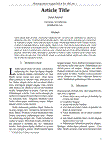| Sumario: | Shrimp farming in Brazil is currently dominated by Litopenaeus vannamei, a species of undisputed zootechnicalmerits. In recent years, however, renewed interest in the farming of the pink shrimp Farfantepenaeus paulensis insouthern Brazil has been stimulated by its market value and higher tolerance to comparatively low temperature levels.F. paulensis proved relatively easy to rear through the larval stages but juveniles reared in ponds perform poorly onformulated feeds, usually displaying low growth rates. Recent research, however, has demonstrated that theseproblems may not be as intractable as previously thought. This paper reviews the latest developments on the nutritionand feeding of F. paulensis, with special reference to the studies conducted over the last decade by our research group.Although extensive ecological and biological research has provided a comprehensive understanding of the biology ofthis commercially important species, relatively little attention has been given to the role of naturally occurring fooditems on its growth and development. One research line to be described in this presentation includes experimentstesting the usefulness of biofilm - a microbial consortium associated with extracellular polymeric substances attachedto submersed surfaces - as a food source for shrimp.In an early study, we found evidence that the biofilm could serve as an important food source. On several trials, wedetected no significant effect in terms of survival, but shrimp from treatments with biofilm had consistently highergrowth rates than those reared in environments where biofilm was either absent or its availability was reduced. As apositive side effect, biofilm present within culture systems resulted in a reduced exportation of phosphorus andammonium.
|
|---|
